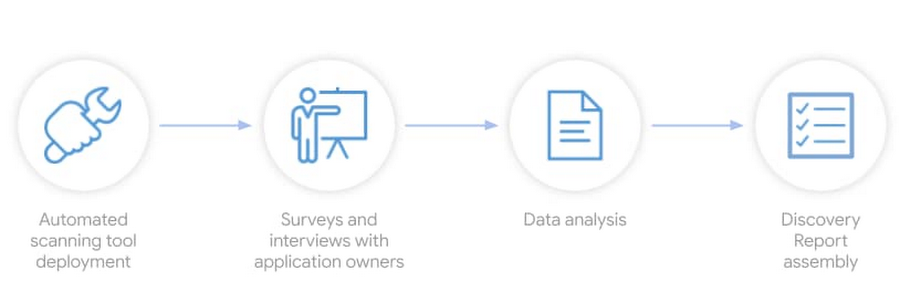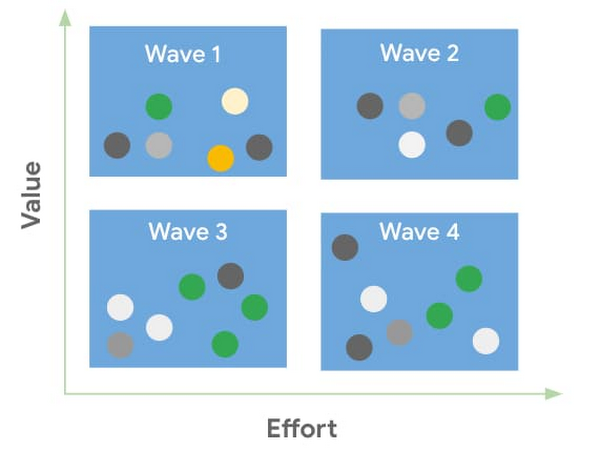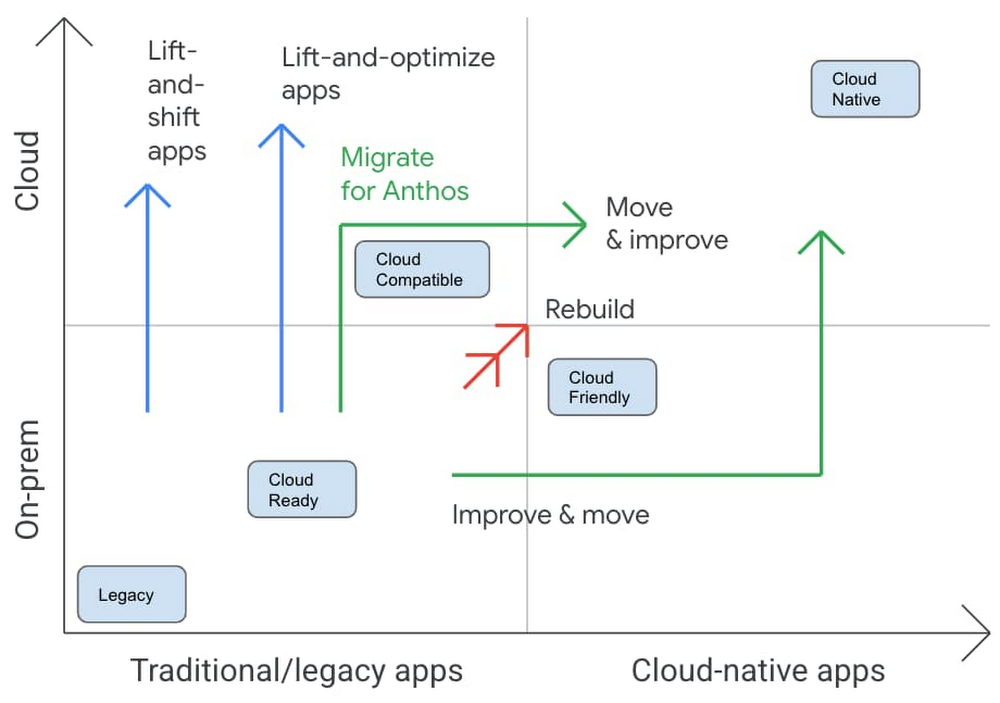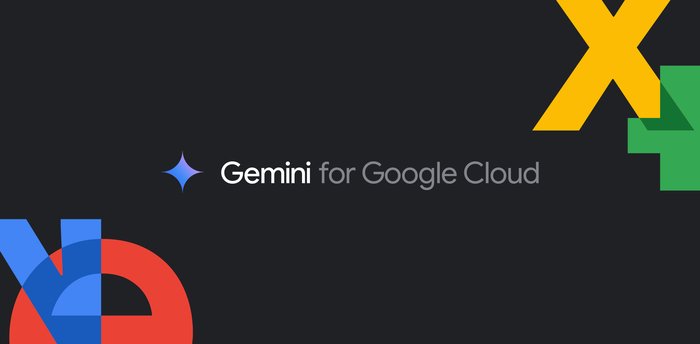Application rationalization: Why you need to take this first step in your migration journey
Poonam Lamba
Product Manager, Google Cloud
Application rationalization is a process of going over the application inventory to determine which applications should be retired, retained, reposted, replatformed, refactored or reimagined. This is an important process for every enterprise in making investment or divestment decisions. Application rationalization is critical for maintaining the overall hygiene of the app portfolio irrespective of where you are running your applications i.e. in cloud or not. However, if you are looking to migrate to the cloud, it serves as a first step towards a cloud adoption or migration journey.
In this blog we will explore drivers and challenges while providing a step-by-step process to rationalize and modernize your application portfolio. This is also the first blog post in a series of posts that we will publish on the app rationalization and modernization topic.
There are several drivers for application rationalization for organizations, mostly centered around reducing redundancies, paying down technical debt, and getting a handle on growing costs. Some specific examples include:
Enterprises going through M&A (mergers and acquisitions), which introduces the applications and services of a newly acquired business, many of which may duplicate those already in place.
Siloed lines of businesses independently purchasing software that exists outside the scrutiny and control of the IT organization.
Embarking on a digital transformation and revisiting existing investments with an eye towards operational improvements and lower maintenance costs. See the CIO guide for app modernization to maximize business value and minimize risk.
What are the challenges associated with application rationalization? We see a few:
Sheer complexity and sprawl can limit visibility, making it difficult to see where duplication is happening across a vast application portfolio.
Zombie applications exist! There are often applications running simply because retirement plans were never fully executed or completed successfully.
Unavailability of up to date application inventory. Are newer applications and cloud services accounted for?
Even if you know where all your applications are, and what they do, you may be missing a formal decisioning model or heuristics in place to decide the best approach for a given application.
Without proper upfront planning and goal setting, it can be tough to measure ROI and TCO of the whole effort leading to multiple initiatives getting abandoned mid way through the transformation process.
Taking an application inventory
Before we go any further on app rationalization, let's define application inventory.
Application inventory is defined as a catalog for all applications that exist in the organization.
It has all relevant information about the applications such as business capabilities, application owners, workload categories (e.g. business critical, internal etc.), technology stacks, dependencies, MTTR (mean time to recovery), contacts, and more. Having an authoritative application inventory is critical for IT leaders to make informed decisions and rationalize the application portfolio. If you don’t have an inventory of your apps, please don’t despair, start with a discovery process and catalogue all the app inventory and assets and repos in one place.
The key for successful application rationalization and modernization is approaching it like an engineering problem—crawl, walk, run; iterative process with a feedback loop for continuous improvement.
Create a blueprint
A key concept in application rationalization/modernization is figuring out the right blueprint for each application.
Retain—Keep the application as is, i.e. host it in the current environment
Retire—Decommission the application and compute at source
Rehost—Migrate it similar compute elsewhere
Replatform—Upgrade the application and re-install on the target
Refactor—Make changes to the application to move towards cloud native traits
Reimagine—Re-architect and rewrite
6 steps to application modernization
The six step process outlined below is a structured, iterative approach to application modernization. Step 1-3 depicts the application rationalization aspects of the modernization journey.


Step 1: Discover—Gather the data
Data is the foundation of the app rationalization process. Gather app inventory data for all your apps in a consistent way across the board. If you have multiple formats of data across lines of businesses, you may need to normalize the data. Typically some form of albeit outdated app inventory can be found in CMDB databases or IT spreadsheets. If you do not have an application inventory in your organization then you need to build one either in an automated way or manually. For automated app discovery there are tools that you can use such as Stratozone, M4A Linux and Windows assessment tools, APM tools such as Splunk, dynatrace, newrelic, and appdynamics and others may also be helpful to get you started. App assessment tools specific to workloads like WebSphere Application Migration Toolkit, Redhat Migration Toolkit for Applications, VMWare cloud suitability analyzer and .NET Portability Analyzer can help paint a picture of technical quality across the infrastructure and application layers. As a bonus, similar rationalization can be done at the data, infrastructure and mainframe tiers too. Watch this space.


At Google, we think of problems as software first and automate across the board (SRE thinking). If you can build an automated discovery process for your infrastructure, applications and data it helps track and assess the state of the app modernization program systematically over the long run. Instrumenting the app rationalization program with DORA metrics enables organizations to measure engineering efficiency and optimize the velocity of software development by focusing on performance.
Step 2: Create cohorts—Group applications
Once you have the application inventory, categorize applications based on value and effort. Low effort e.g. stateless applications,microservices or applications with simple dependencies etc. and high business value will give you the first wave candidates to modernize or migrate.


Step 3: Map out the modernization journey
For each application, understand its current state to map it to the right destination on its cloud journey. For each application type, we outline the set of possible modernization paths. Watch out for more content in this section in upcoming blogs.
Not cloud ready (Retain, Rehost, Reimagine)—These are typically monolithic, legacy applications which run on the VM, take a long time to restart, not horizontally scalable. These applications sometimes depend on the host configuration and also require elevated privileges.
Container ready (Rehost, Refactor and Replatform)—These applications can restart, have readiness and liveliness probes, logs to stdout. These applications can be easily containerized.
Cloud compatible (Replatform)—In addition to container ready, typically these applications have externalized configurations, secret management, good observability baked in. The apps can also scale horizontally.
Cloud friendly—These apps are stateless, can be disposed of, have no session affinity, and have metrics that are exposed using an exporter.
Cloud Native—These are API first, easy to integrate cloud authentication and authorization apps. They can scale to zero and run in serverless runtimes.
The picture below shows where each of this category lands on the modernization journey and a recommended way to start modernization.
This will drive your cloud migration journey, e.g. lift and shift, move and improve etc.


Once you have reached this stage, you have established a migration or change path for your applications. It is useful to think of this transition to cloud as a journey, i.e. an application can go through multiple rounds of migration and modernization or vice-versa as different layers of abstractions become available after every migration of modernization activity.
Step 4: Plan and Execute
At this stage you have gathered enough data about the first wave of applications. You are ready to put together an execution plan, along with the engineering, DevOps and operations/SRE teams. Google Cloud offers solutions for modernizing applications, one such example for Java is here.
At the end of this phase, you will have the following (not an exhaustive list):
An experienced team who can run and maintain the production workloads in cloud
Recipes for app transformation and repeatable CI/CD patterns
A security blueprint and data (in transit and at rest) guidelines
Application telemetry (logging, metrics, alerts etc.) and monitoring
Apps running in the cloud, plus old apps turned off realizing infrastructure and license savings
Runbook for day 2 operations
Runbook for incident management
Step 5: Assess ROI
ROI calculations include a combination of:
Direct costs: hardware, software, operations, and administration
Indirect costs: end-user operations and downtime
It is best to capture the current/as is ROI and projected ROI after the modernization effort. Ideally this is in a dashboard and tracked with metrics that are collected continuously as applications flow across environments to prod and savings are realized. The Google CAMP program puts in place a data-driven assessment and benchmarking, and brings together a tailored set of technical, process, measurement, and cultural practices along with solutions and recommendations to measure and realize the desired savings.
Step 6: Rinse and Repeat
Capture the feedback from going over the app rationalization steps and repeat for the rest of your applications to modernize your application portfolio. With each subsequent iteration it is critical to measure key results and set goals to create a self propelling, self improving fly wheel of app rationalization.
Summary
App rationalization is not a complicated process. It is a data driven, agile, continuous process that can be implemented and communicated within the organization with the executive support.
Stay tuned: As a next step, we will be publishing a series of blog posts detailing each step in the application rationalization and modernization journey and how Google Cloud can help.




